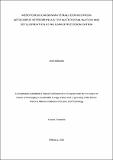| dc.contributor.author | Elisadiki, Joyce | |
| dc.date.accessioned | 2020-10-06T10:54:31Z | |
| dc.date.available | 2020-10-06T10:54:31Z | |
| dc.date.issued | 2020-02 | |
| dc.identifier.uri | https://doi.org/10.58694/20.500.12479/956 | |
| dc.description | A Dissertation Submitted in Partial Fulfillment of the Requirements for the Degree of
Doctor of Philosophy in Sustainable Energy Science and Engineering of the Nelson
Mandela African Institution of Science and Technology | en_US |
| dc.description.abstract | Sustainable clean water for human use can be attained through cost-effective water
purification technologies whereby capacitive deionization (CDI) technology is among them.
To attain high CDI performance porous carbon materials with high surface area, specific
capacitance, and good chemical stability are essential. In this study, high surface area
mesoporous carbon has been synthesized from jackfruit peels (Artocarpus heterophyllus)
through chemical activation method. Two different activation routes were used; carbonization
followed by KOH activation and direct activation with H
3
PO
4
. In KOH activation route, the
activation process was done by varying activation temperature from 600 to 800 ˚C and KOH
to carbon ratio (KOH/C) from 1 to 3 for 1 h. In H
3
PO
4
route, activation was done by varying
concentration of H
3
PO
4
from 10 to 35% and activation temperature from 450 to 550 ˚C for 1
h. The textural properties of the synthesized jackfruit activated carbon (JFAC) and
electrochemical characteristics of the fabricated electrodes were found to be influenced by
activating agent ratio/concentration and activation temperature. The synthesized JFAC
possess a honey comb-like structure with plentiful mesopores at a pore size range of 3.0-5.0
nm which are beneficial for electrosorption. The BET surface area and pore volume of the
carbonized jackfruit peels (JFC) increased from 607 to 2681 m
2
/g and 0.52 to 2.61 cm
3
/g
respectively, upon activation with KOH/C ratio of 2 at 800 °C. Nitrogen adsorptiondesorption
studies
revealed
that
the
synthesized
JFAC
is
mainly
mesopores
characterized
by
type
IV
isotherms
according
to
IUPAC
classification.
Desalination
experiments
were
carried
out
with 30 to 500 mg/L NaCl solution in batch mode at a flow rate of 2.5 mL/min while
applying a voltage of 1.2, 1.4 and 2.0 V to the cell. The electrosorption capacity and saltremoval
efficiency
increased
with
increasing
BET
surface
area
and
applied
potential.
Among
the
samples studied, carbon produced with KOH/C ratio of 1 at 700 ˚C (JFAC-1-700)
exhibited the highest specific capacitance of 307 F/g, high salt removal efficiency and
electrosorption capacity of 5.74 mg/g when voltage of 2 V was applied. When JFAC
electrodes were studied for natural water defluoridation, it was found that JFAC CDI
electrodes could remove fluoride (Fˉ) from natural water containing low Fˉ concentrations to
the permissible limits set by the World Health Organization (WHO). Maximum Fˉ adsorption
efficiency (62%) and electrosorption capacity (0.13 mg/g) were attained with applied voltage
of 2 V and the pH of water remained unaffected. These results indicated that the Artocarpus
heterophyllus peels can be the promising CDI electrode materials for low salinity water
desalination and defluoridation. | en_US |
| dc.language.iso | en | en_US |
| dc.publisher | NM-AIST | en_US |
| dc.rights | Attribution-NonCommercial-ShareAlike 4.0 International | * |
| dc.rights.uri | http://creativecommons.org/licenses/by-nc-sa/4.0/ | * |
| dc.subject | Research Subject Categories::NATURAL SCIENCES | en_US |
| dc.title | Mesoporous carbon materials derived from artocarpus heterophyllus for water desalination and defluoridation using capacitive deionization | en_US |
| dc.type | Article | en_US |


